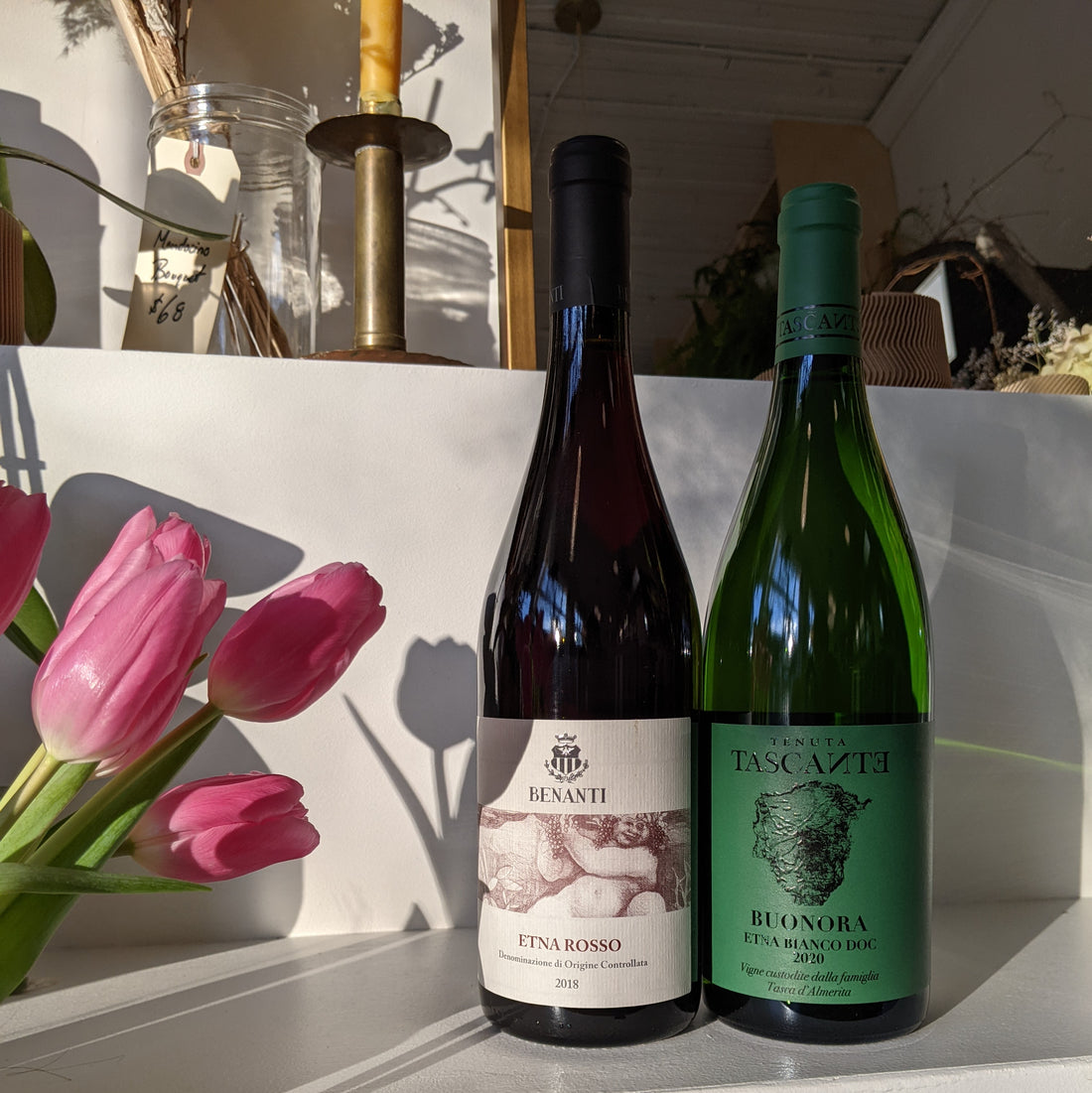
January 2022 - Mt. Etna, Sicily
January 2022
Mt. Etna, Sicily
Featuring:
Tenuta Tascante, ‘Buonora’ Etna Bianco 2020
Benanti, Etna Rosso 2018
At a glance:
- Fascinating geographic features that are rarely seen together - higher altitudes, incredibly volcanic soils, Mediterranean influence
- Red-hot winegrowing region, rising from near obscurity to a household name in less than 30 years
- The North slope is most prominent for grape growing. The East/South sides are also home to a number of vineyards. The hotter West-slope is still largely planted to pistachio trees.
- Reds/Rose are based off of Nerello Mascalese with Nerello Cappuccio lending support in blends.
- Whites are usually Carricante, with Catarratto sometimes blended
There are few regions as exciting, unique, bizarre, mind-bending, you name it, as Sicily’s Mount Etna.
Not only is Etna a high elevation wine growing region with a number of micro-climates all over the mountain, but it is also an ACTIVE volcano that is erupting on a near-constant basis. If you’re reading this, there’s about a 50/50 chance it’s currently spewing ash and lava (current updates found here). This is evident in the fact that the ‘named slopes/vineyards’ we call ‘Cru’ in Burgundy or Piedmont don’t exist but are rather called Contrade’s and are named after different lava flows of varying ages (usually thousands of years to become plantable).
As mentioned, the region has risen from near obscurity in the early 2000’s to a household name today. In terms of wine regions, where the most famous have been firmly established for centuries, this is a lifetime achievement in a nano-second. While Etna was given DOC status in 1968, most of the wine was thought of as poor quality (as was Sicilian wine in general) and only drank locally. Thanks to the work of several pioneers, including the long-established Benanti family, vigneron extraordinaire Salvo Foti, and Dutchman and natural wine advocate Frank Cornelissen, the region has seen a total resurgence. It is now a magnet for dozens of other winemakers - both new and established - to stake their claim on the mountain.
Lastly, the geography is highly demanding as far as farming and winemaking. The steep slopes make mechanization incredibly difficult (if possible at all), and the vines are often trained in the albarello form (aka head-trained, bush-trained or Gobelet in French). This combination makes any sort of mechanized or mass-farming incredibly hard. The result is most growers on Etna are passion-driven small producers who still farm and make the wines largely by hand. This has always been true, with traditional Etna wineries actually just being extensions of homes. Old wineries on Etna were called Palmentos and used to be a part of the family home. In the palmento, grapes would be brought through a window (brought by mule-drawn cart, or foot) where they were stomped to juice in a large, gently sloping basin. The juice would run down the slope, through a hole, and into an open top stone fermenter. Here the juice would ferment to wine and it would be drained, again with gravity, into bottles or jugs for drinking. No fancy pumps or presses, no inert gas or oxidation-prevent methods, or even yeasts or oak barrels. Just grapes, gravity, and human power. Now, I can’t say if these ancient Etna wines were good, but there’s something beautiful about the simplicity.
There's SO MUCH more to Etna than I could fit in one writeup. People have written whole books about the wine culture on the mountain. Because it’s so young and so simple, it’s actually a pretty fun region to nerd out on. If the above information at all enticed you, I implore you to research more.
Tenuta Tascante, ‘Buonora’ Etna Bianco 2020
For the first of our two Etna wines, we have a classic example of a long-established Italian producer recently staking their claim on the mountain. In 2007, Tasca d’Almerita, a leading producer in Western Sicily, purchased two vineyard sites in Castiglione di Sicilia and Randazzo, on the Northern side of the mountain. For the first several years, they produced the wine at their main winery, near Palermo, and were forbidden from putting Etna on the label due to local laws. In 2016 they were able to acquire an existing winery on the mountain and can now label the wines as such. Today, the winery is helmed by Alberto Tasca (7th generation winemaker) and has 4 vineyards on the North and East sides of the mountain.
This wine, the ‘Buonora’, is 100% Carricante. Typically, Carricante has been grown on the most shaded Eastern side of the mountain where the proximity to the cooling effects of the sea are also more prominent. The grape often has notes of green almond along with a fleshy and highly mineral texture reminiscent of Chardonnay (but Chablis, not California Chardonnay). This wine, which is entirely fermented and aged in stainless steel, is a wonderful example of the purity of fruit, saltiness, and driving acidity of the grape. Drink now or over the next 5 years. Pairs well with any sort of seafood or non-tomato pasta.
Benanti, Etna Rosso 2018
On the other side of the coin as Tascante, you have the Benanti Family. In the 1980s, Guiseppe Benanti started acquiring vineyards on the mountain and hired a young enologist named Salvo Foti to help make the wines. He used clonal material his grandfather has helped propagate - and even save - to plant new vineyards and revive old ones. Some of the only quality ‘library’ wines you can find from Etna today are from Benanti - and they’re delicious.
But while the Benanti’s may be the godfathers of Mount Etna today, it hasn’t always been like this. The family had to struggle for years with slow sales and general disinterest in the mountain before they found success.
This wine is the most straightforward entrypoint to the Benanti portfolio. 80% of the blend is Nerello Mascalese, which is the principal grape of Etna and has a firm yet tense structure (similar to Nebbiolo mixed with Pinot). Nerello Cappuccio makes up the other 20%, and is meant to add body, roundness, and ripe black fruit. Stainless steel fermented and whisper of oak make this wine vibrant, full of fresh red cherry fruit, and utterly delicious. Pairs well with grilled meats or, a personal favorite, Pasta alla Norma.
